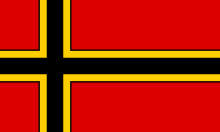Josef Wirmer
This article includes a list of general references, but it lacks sufficient corresponding inline citations. (January 2015) |

Josef Wirmer (19 March 1901 – 8 September 1944) was a German jurist and resistance fighter against the Nazi regime.
Life
Born in
In 1936, Wirmer came into contact with the trade-unionist resistance circles about

After Stauffenberg's plans failed and Hitler survived the bombing at the
"Joseph Wirmer, yes you belong to a black faction (black meant Catholic Centre Party at the time), yes that's what you're taken for, that can't be otherwise. It's weird. How important the position as a civilian lawyer that you have had must have been that you never once became a soldier at that age. And from then on you have been mobilized, which also speaks for your attitude, that you first wait, until someone mobilizes you. Fine rascal. (Shouting loudly) Yes, yes, yes, fine rascal!"
he replied,
"When I hang, I'll have no fear, but you will!"
When Freisler retorted that Wirmer would soon be going to hell, he answered with a "courtly bow",
"I'll look forward to your own imminent arrival, Mr. President!"

On 8 September 1944, Josef Wirmer was sentenced to death by the Volksgerichtshof. Two hours after the sentence had been handed down at the
Wirmer flag

Taking up long-lasting controversies surrounding the
After the war, when the West German Herrenchiemsee convention worked out a new constitution in 1948, Wirmer's flag design was again discussed. Though initially backed by Christian Democrats and German Party delegates, it was ultimately rejected in favor of a former black, red and gold tricolour.[1] In the 1950s, the Christian Democratic Union as well as the Free Democratic Party temporarily adopted the Cross flag as party banners.
In recent times the Wirmer flag has come to be adopted by Neue Rechte movements, such as Hogesa or pro NRW, and is regularly displayed at Pegida rallies. This is a source of condemnation by many, who see it as an insult to the resistance, but others claim the use of the Wirmer flag is justified, as the aforementioned groups claim they resist just as the German resistance did.[2]
See also
Literature
- Friedrich G Hohmann (Hg.): Deutsche Patrioten in Widerstand und Verfolgung 1933-1945 : Paul Lejeune-Jung - Theodor Roeingh - Josef Wirmer - Georg Frhr. von Boeselager. Schöningh ISBN 3-506-73935-2
- Josef Wirmer - ein Gegner Hitlers. Essays and Documents, 2. Aufl. 1993 ISBN 3-922032-25-7
- Annedore Leber (publisher): Das Gewissen steht auf : 64 Lebensbilder aus d. dt. Widerstand 1933 - 1945 / gesammelt von Annedore Leber. Hrsg. in Zusammenarb. mit Willy Brandt u. Karl Dietrich Bracher. 10. Aufl., Berlin 1963 ISBN B0000BKS1R
- Jan Schlürmann: Die „Wirmer-Flagge“ - die wechselhafte Geschichte eines vergessenen Symbols der deutschen Christlichen Demokratie, in: Historisch-Politische Mitteilungen. Archiv für Christlich-Demokratische Politik 22 (2015), p. 331-342.
References
External links
![]() Media related to Josef Wirmer at Wikimedia Commons
Media related to Josef Wirmer at Wikimedia Commons
- Josef Wirmer in the German National Library catalogue
- Josef Wirmer at KStV Guestphalia-Berlin
